1997 CHEVROLET CAVALIER overheating
[x] Cancel search: overheatingPage 130 of 388
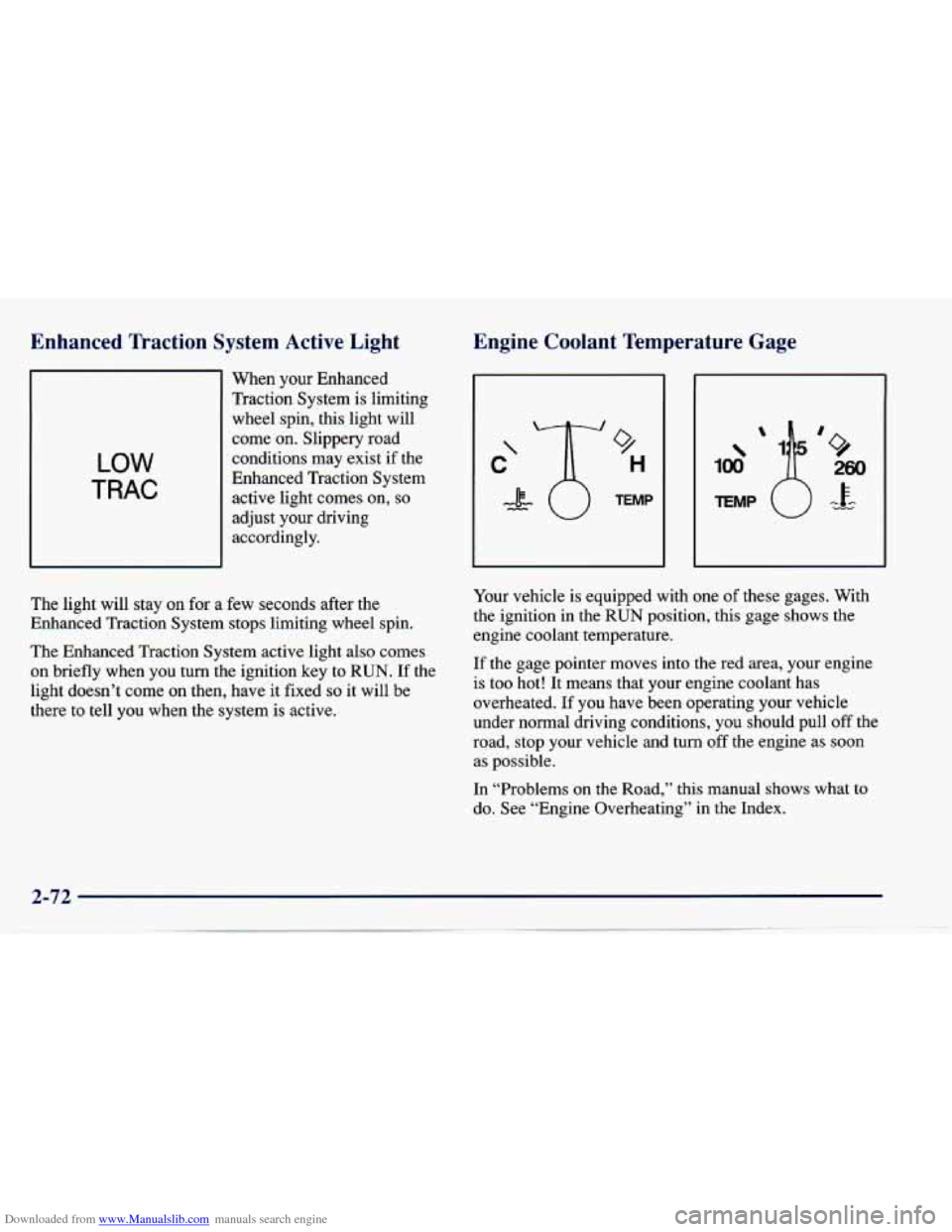
Downloaded from www.Manualslib.com manuals search engine Enhanced Traction System Active Light
LOW
TRAC
When your Enhanced
Traction System is limiting
wheel spin, this light will
come on. Slippery road
conditions may exist if the
Enhanced Traction System active light comes on,
so
adjust your driving
accordingly.
The light will stay
on for a few seconds after the
Enhanced Traction System stops limiting wheel spin.
The Enhanced Traction System active light also comes
on briefly when you turn the ignition key to
RUN. If the
light doesn’t come
on then, have it fixed so it will be
there
to tell you when the system is active.
Engine Coolant Temperature Gage
9
H
TEMP
Your vehicle is equipped with one of these gages. With
the ignition in the
RUN position, this gage shows the
engine coolant temperature.
If the gage pointer moves into the red
area, your engine
is too hot! It means that your engine coolant has
overheated.
If you have been operating your vehicle
under normal driving conditions,
you should pull off the
road, stop your vehicle and turn off the engine as soon
as possible.
In “Problems on the Road,” this manual shows what to
do. See “Engine Overheating” in the Index.
Page 204 of 388
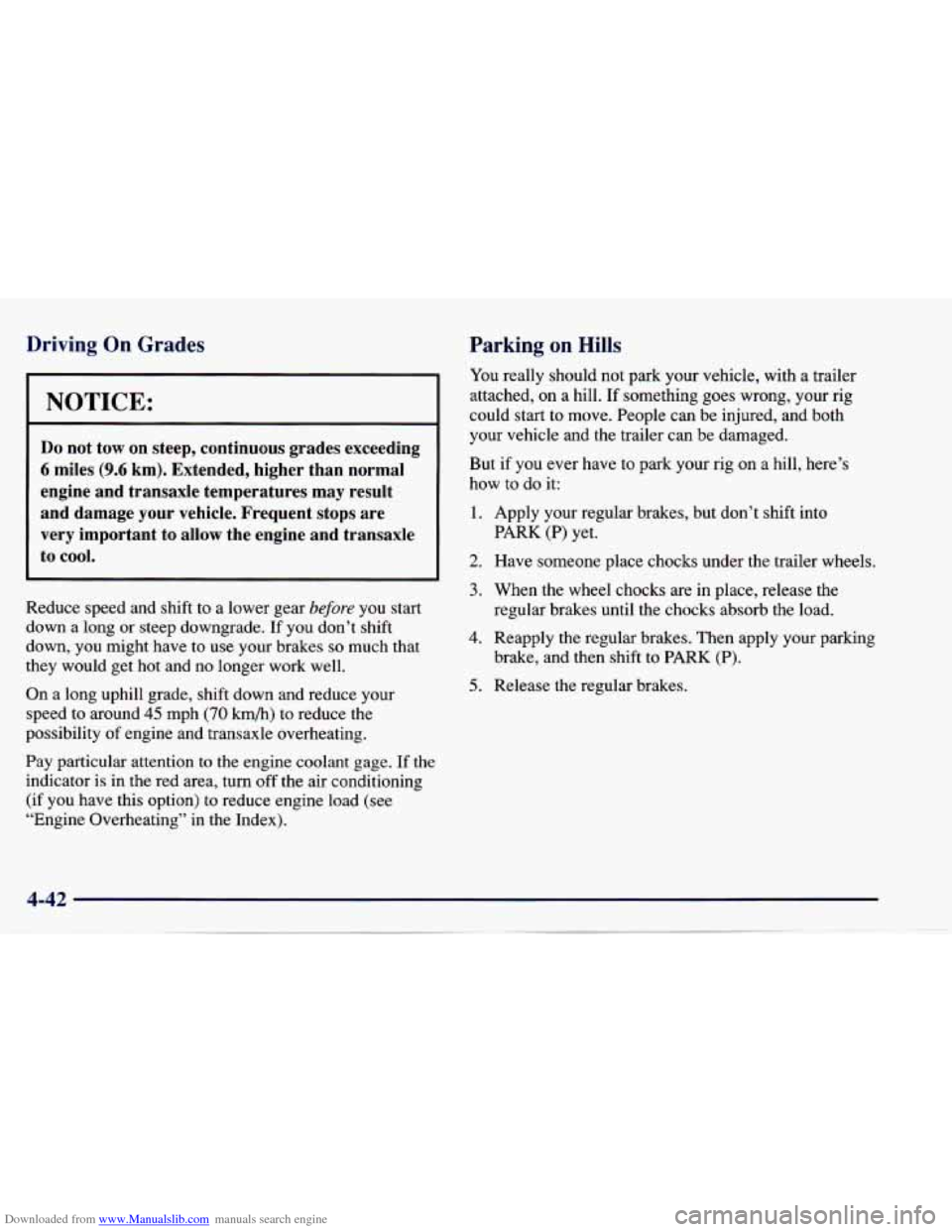
Downloaded from www.Manualslib.com manuals search engine Driving On Grades
NOTICE:
Do not tow on steep, continuous grades exceeding
6 miles (9.6 km). Extended, higher than normal
engine and transaxle temperatures may result
and damage your vehicle. Frequent stops are very important to allow the engine and transaxle
to
cool.
Reduce speed and shift to a lower gear before you start
down a long or steep downgrade. If you don’t shift
down, you might have to use your brakes
so much that
they would get hot and no longer work well.
On a long uphill grade, shift down and reduce your
speed to around
45 mph (70 km/h) to reduce the
possibility of engine and transaxle overheating.
Pay particular attention
to the engine coolant gage. If the
indicator is in the red area, turn off the air conditioning
(if you have this option)
to reduce engine load (see
“Engine Overheating” in the Index).
Parking on Hills
You really should not park your vehicle, with a trailer
attached,
on a hill. If something goes wrong, your rig
could start to move. People can be injured, and both
your vehicle
and the trailer can be damaged.
But
if you ever have to park your rig on a hill, here’s
how
to do it:
1.
2.
3.
4.
5.
Apply your regular brakes, but don’t shift into
PARK (P) yet.
Have someone place chocks under the trailer wheels.
When
the wheel chocks are in place, release the
regular brakes until the chocks absorb the load.
Reapply the regular brakes. Then apply your parking
brake, and then shift
to PARK (P).
Release the regular brakes.
Page 207 of 388
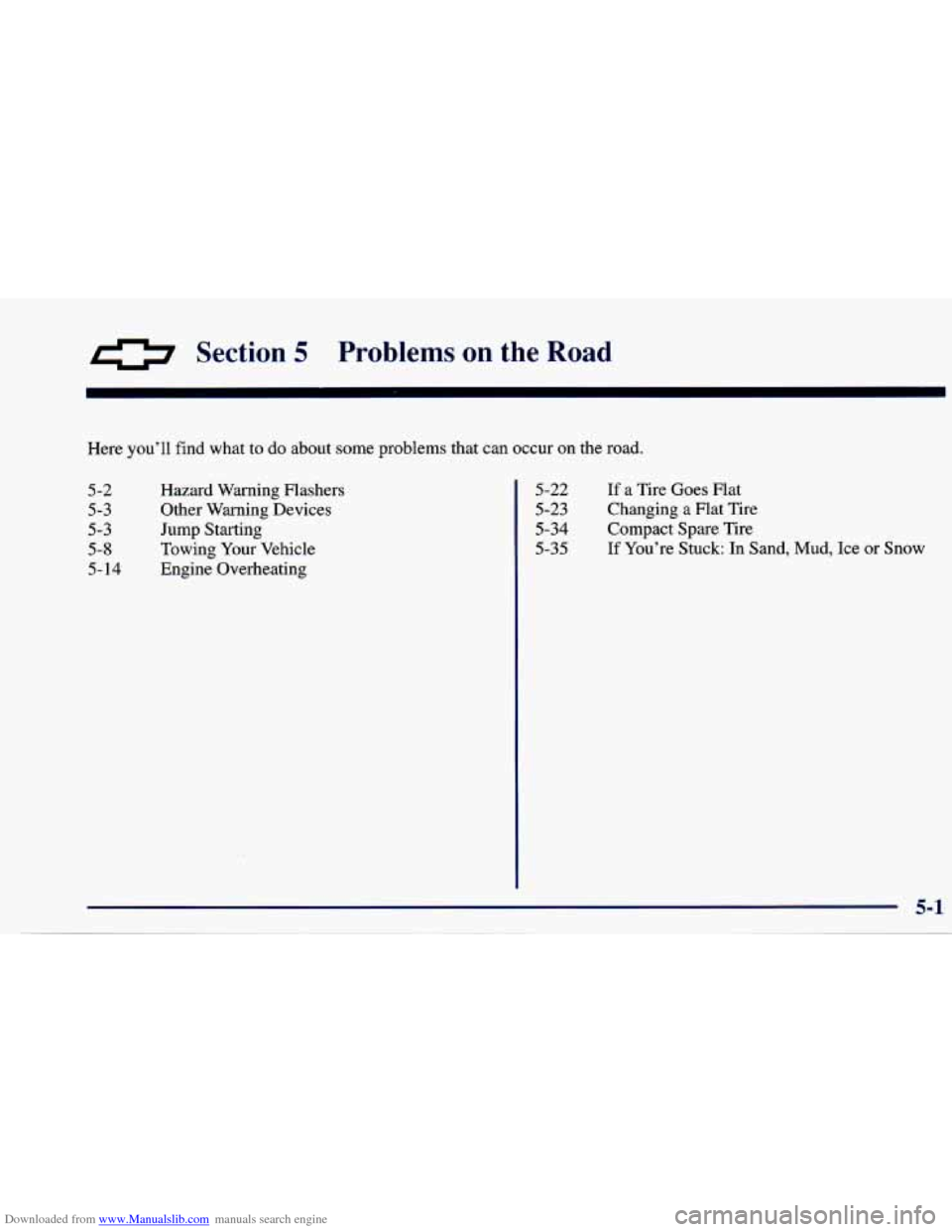
Downloaded from www.Manualslib.com manuals search engine 0 Section 5 Problems on the Road
Here you’ll find what to do about some problems that can occur on the road.
5-2
5-3
5-3
5-8
5-
14
Hazard Warning Flashers
Other Warning Devices
Jump Starting
Towing Your Vehicle
Engine Overheating 5-22
5-23
5-34
5-35
If a Tire Goes Flat
Changing a Flat Tire
Compact Spare Tire
If You’re
Stuck: In Sand, Mud, Ice or Snow
Page 223 of 388
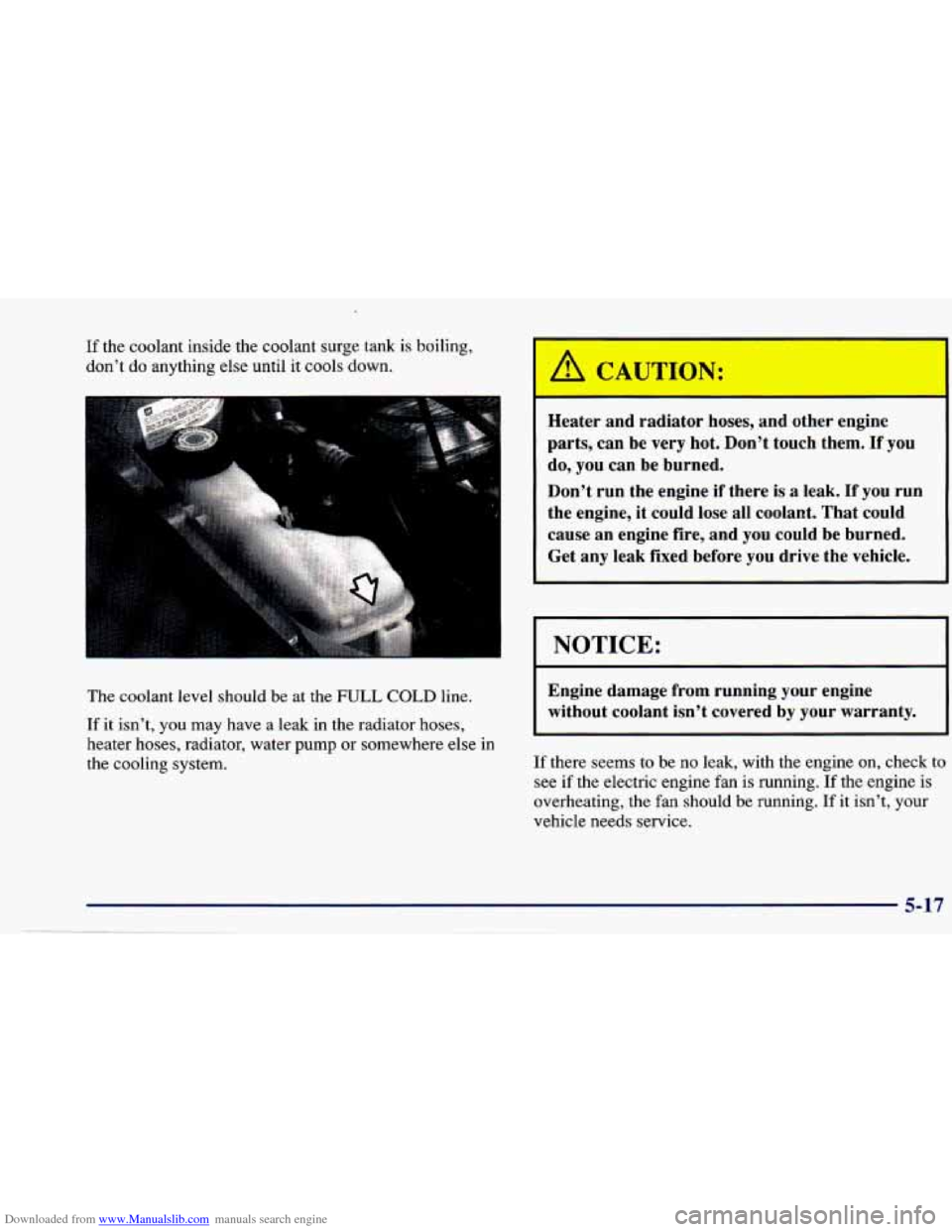
Downloaded from www.Manualslib.com manuals search engine If the coolant inside the coolant surge tank is boiling,
don’t
do anything else until it cools down.
The coolant level should be at the
FULL COLD line.
If it isn’t, you may have a leak in the radiator hoses,
heater hoses, radiator, water
pump or somewhere else in
the cooling system.
A CAUTION:
Heater and radiator hoses, and other engine
parts, can be very hot. Don’t touch them. If you
do, you can be burned,
Don’t run the engine if there
is a leak. If you run
the engine, it could lose all coolant, That could
cause an engine fire, and you could be burned.
Get any leak fixed before you drive the vehicle.
NOTICE:
Engine damage from running your engine
without coolant isn’t covered
by your warranty.
If there seems to
be no leak, with the engine on, check to
see if the electric engine fan is running.
If the engine is
overheating, the fan should be running.
If it isn’t, your
vehicle needs service.
5-1
. .
Page 267 of 388
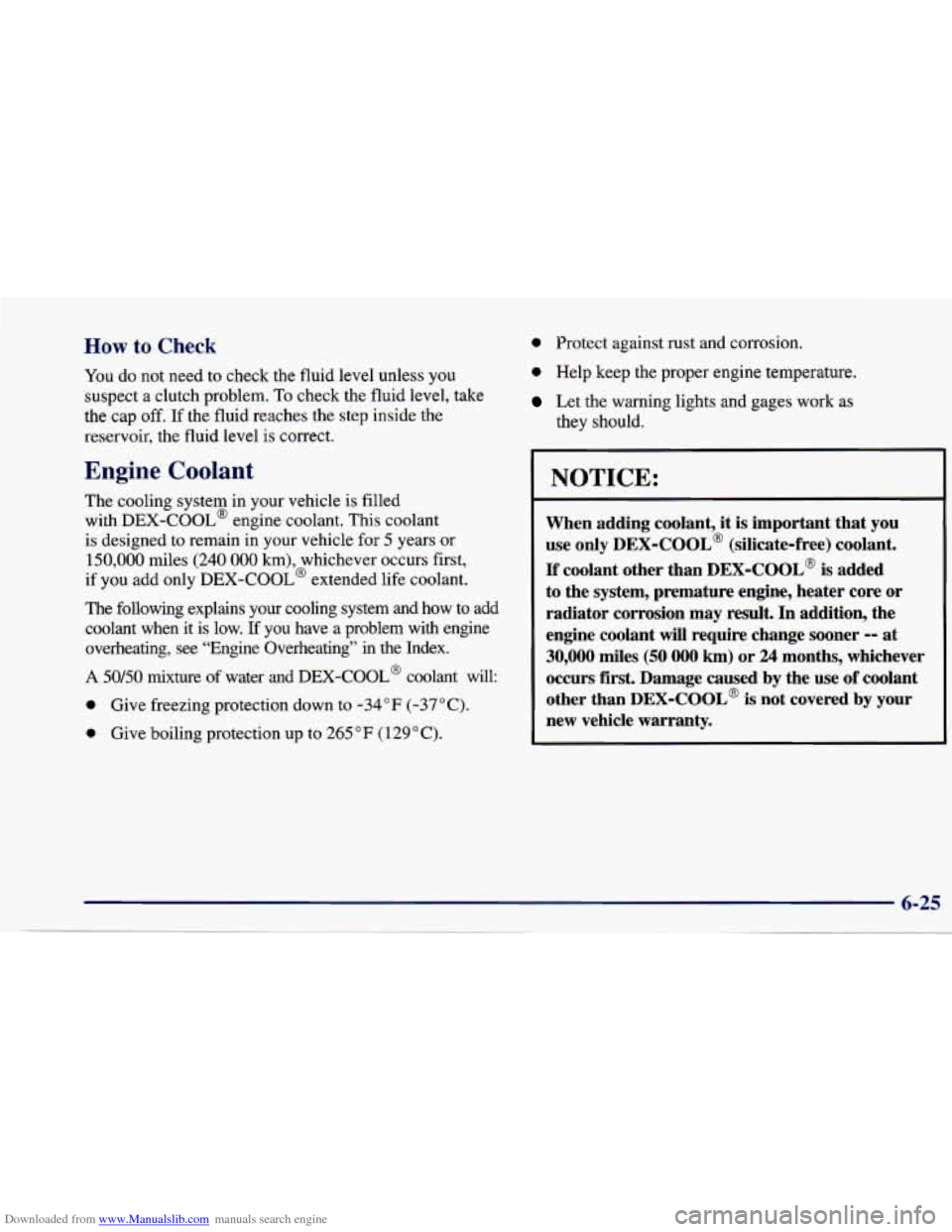
Downloaded from www.Manualslib.com manuals search engine How to Check
You do not need to check the fluid level unless you
suspect
a clutch problem. To check the fluid level, take
the cap
off. If the fluid reaches the step inside the
reservoir, the fluid level
is correct.
Engine Coolant
The cooling system in your vehicle is filled
with DEX-COOL@ engine coolant. This coolant
is designed to remain in your vehicle for
5 years or
150,000 miles (240 000 km), whichever occurs first,
if you add only DEX-COOL@ extended life coolant.
The following explains your cooling system and how to add
coolant when it is low.
If you have a problem with engine
overheating, see “Engine Overheating”
in the Index.
A 50/50 mixture of water and DEX-COOL@ coolant will:
0 Give freezing protection down to -34°F (-37°C).
0 Give boiling protection up to 265 “F (129°C).
0 Protect against rust and corrosion.
0 Help keep the proper engine temperature.
Let the warning lights and gages work as
they should.
NOTICE:
I
When adding coolant, it is important that you
use only
DEX-COOL@ (silicate-free) coolant.
If coolant other than
DEX-COOL’ is added
to the system, premature engine, heater core or
radiator corrosion may result. In addition, the
engine coolant will require change sooner
-- at
30,000 miles (50 000 km) or 24 months, whichever
occurs
first. Damage caused by the use of coolant
other than
DEX-COOL@ is not covered by your
new vehicle warranty.
Page 270 of 388
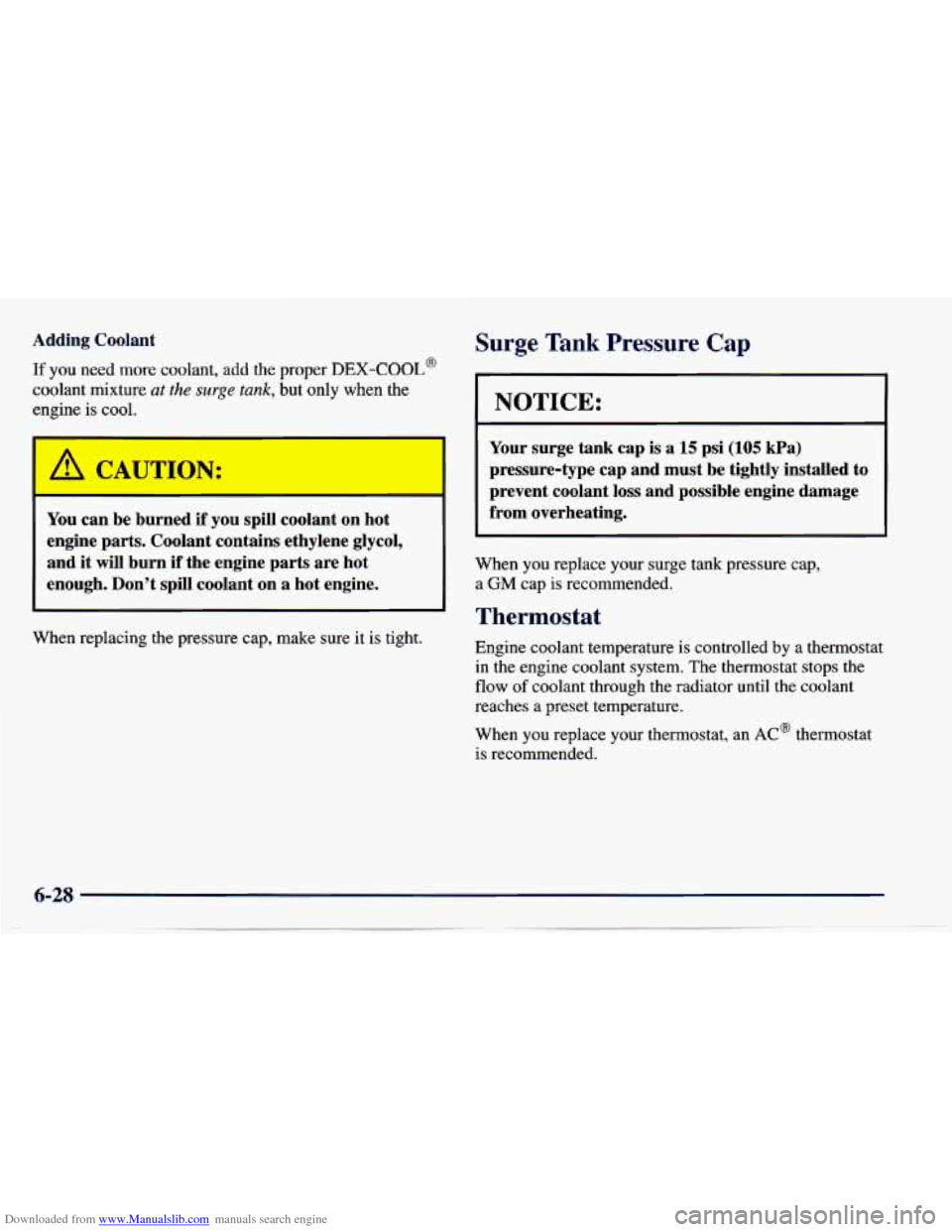
Downloaded from www.Manualslib.com manuals search engine Adding Coolant
If you need more coolant, add the proper DEX-COOL@
coolant mixture at the surge tank, but only when the
engine
is cool.
~~
A CAUTION:
You can be burned if you spill coolant on hot
engine parts. Coolant contains ethylene glycol,
and it will burn
if the engine parts are hot
enough. Don’t spill coolant
on a hot engine.
When replacing the pressure cap, make sure it is tight.
Surge Tank Pressure Cap
NOTICE:
Your surge tank cap is a 15 psi (105 kPa)
pressure-type cap and must be tightly installed
to
prevent coolant loss and possible engine damage
from overheating.
When you replace your surge tank pressure cap,
a
GM cap is recommended.
Thermostat
Engine coolant temperature is controlled by a thermostat
in the engine coolant system. The thermostat stops the
flow of coolant through the radiator until the coolant
reaches a preset temperature.
When you replace your thermostat, an
AC@ thermostat
is recommended.
Page 282 of 388
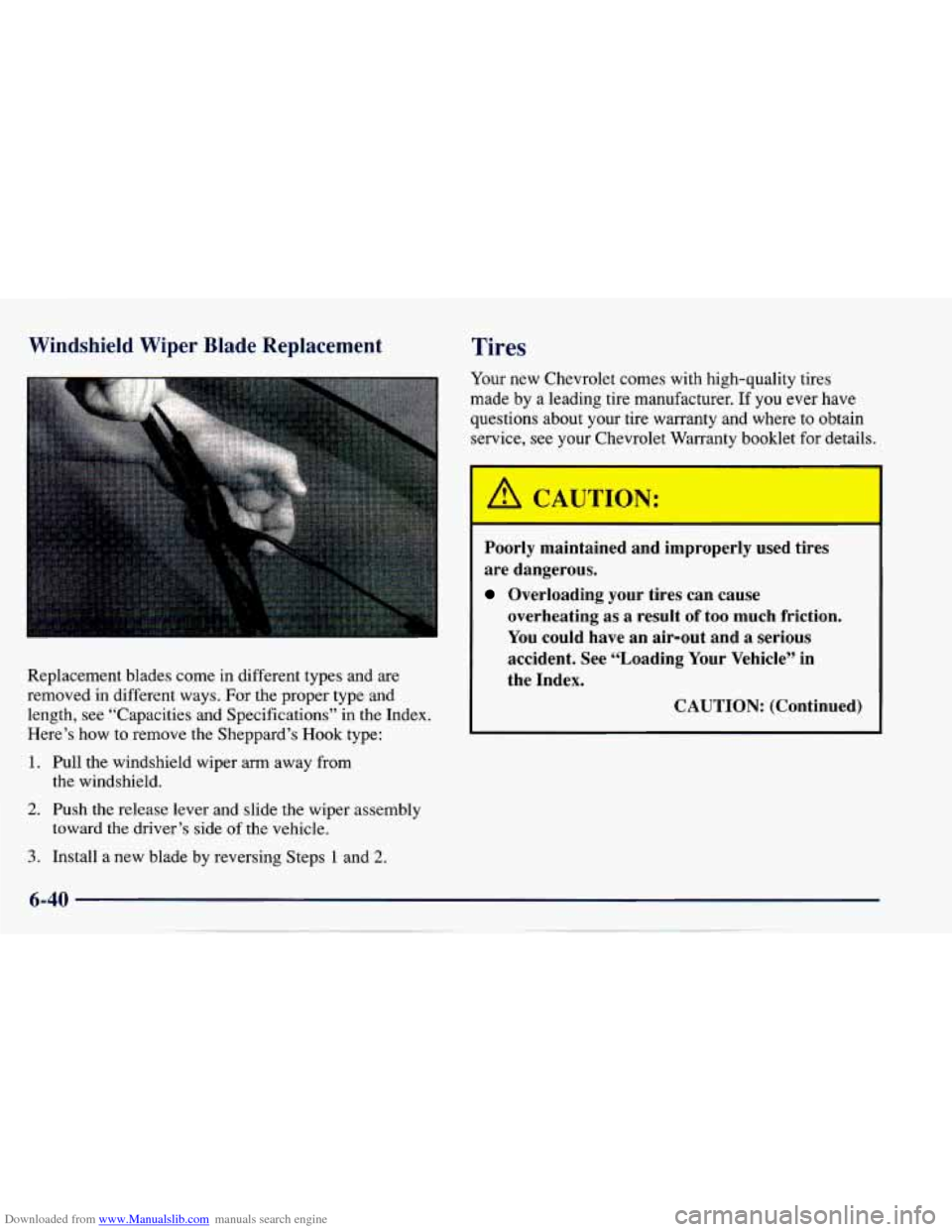
Downloaded from www.Manualslib.com manuals search engine Windshield Wiper Blade Replacement
Replacement blades come in different types and are
removed in different ways. For the proper type and
length, see “Capacities and Specifications” in the Index.
Here’s how to remove the Sheppard’s Hook type:
1. Pull the windshield wiper arm away from
the windshield.
2. Push the release lever and slide the wiper assembly
3. Install a new blade by reversing Steps 1 and 2.
toward the driver’s side of the vehicle.
Tires
Your new Chevrolet comes with high-quality tires
made by
a leading tire manufacturer. If you ever have
questions about your tire warranty and where to obtain
service, see your Chevrolet Warranty booklet for details.
I A CAUTION:
Poorly maintained and improperly used tires
are dangerous.
Overloading your tires can cause
overheating as
a result of too much friction.
You could have an air-out and a serious
accident. See “Loading
Your Vehicle” in
the Index.
CAUTION: (Continued)
Page 378 of 388
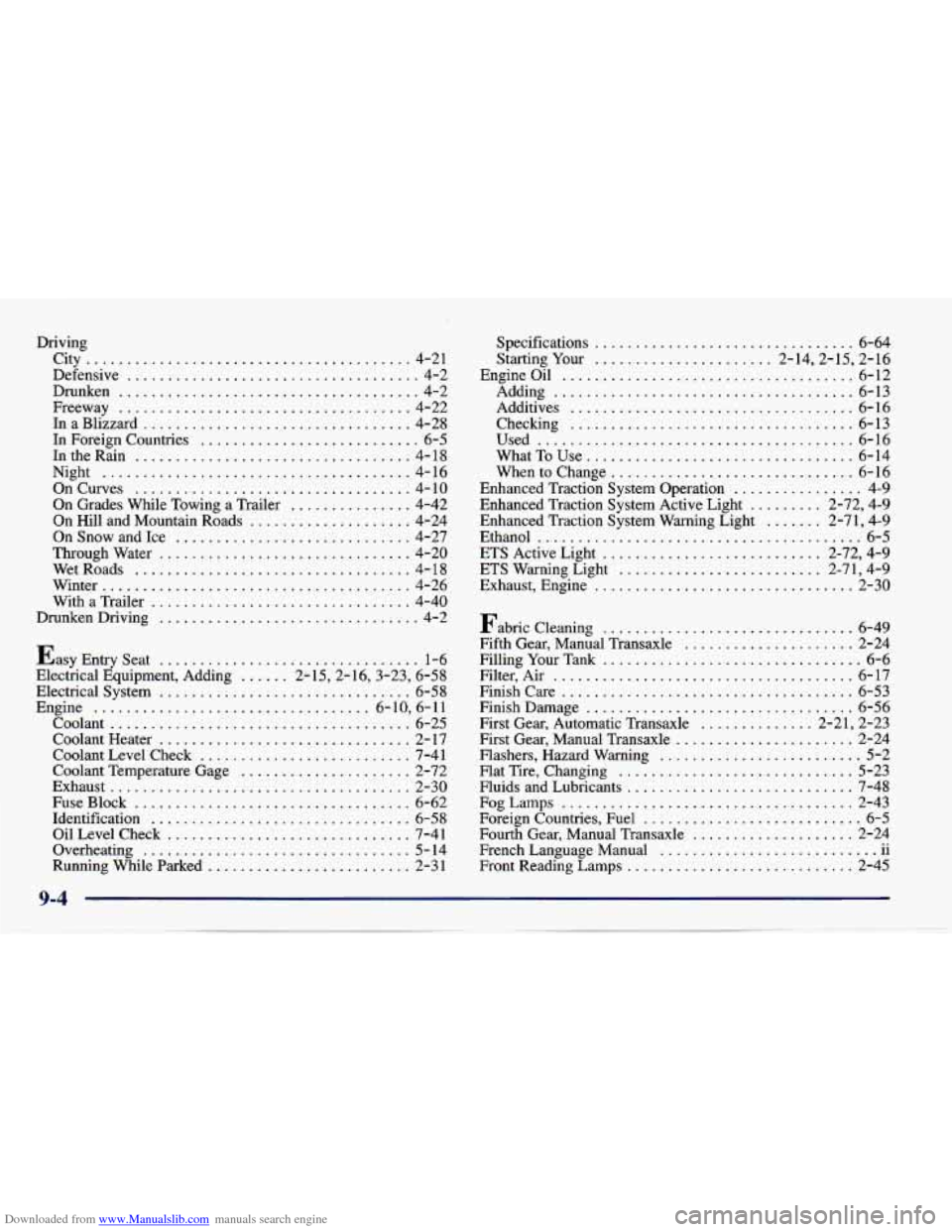
Downloaded from www.Manualslib.com manuals search engine Driving City
........................................ 4-21
Defensive
.................................... 4-2
Drunken
..................................... 4-2
Freeway
.................................... 4-22
InaBlizzard
................................. 4-28
In Foreign Countries
........................... 6-5
In the Rain
.................................. 4- 18
Night
...................................... 4-16
OnCurves
.................................. 4-10
On Grades While Towing a Trailer
............... 4-42
On Hill and Mountain Roads
.................... 4-24
OnSnowandIce
............................. 4-27
Throughwater
............................... 4-20
WetRoads
.................................. 4-18
Winter
...................................... 4-26
With a Trailer
................................ 4-40
DrunkenDriving
................................ 4-2
Easy Entry Seat ................................ 1-6
Electrical Equipment. Adding ...... 2-15.2-16.3-23. 6-58
Electrical System
............................... 6-58
Engine
.................................. 6-10. 6-11
Coolant
..................................... 6-25
Coolant Heater
............................... 2- 17
Coolant Level Check
.......................... 7-41
Coolant Temperature Gage
..................... 2-72
Exhaust
..................................... 2-30
Fuse Block
.................................. 6-62
Identification
................................ 6-58
OilLevelCheck
.............................. 7-41
Overheating
................................. 5-14
Running While Parked
......................... 2-31 Specifications
................................ 6-64
Starting Your
...................... 2.14.2.15. 2.16
Engineoil
.................................... 6-12
Adding
..................................... 6-13
Additives
................................... 6-16
Checking
................................... 6-13
Used
....................................... 6-16
What
To Use ................................. 6-14
When to Change
.............................. 6-16
Enhanced Traction System Operation
................ 4-9
Enhanced Traction System Active Light
......... 2.72. 4.9
Enhanced Traction System Warning Light
....... 2.71. 4.9
Ethanol
........................................ 6-5
ETS Active Light ........................... 2.72. 4.9
ETS Warning Light
......................... 2.71. 4.9
Exhaust. Engine
................................ 2-30
Fabric Cleaning
............................... 6-49
Fifth Gear. Manual Transaxle
..................... 2-24
Filling Your Tank ................................ 6-6
Filter. Air
..................................... 6-17
Finishcare
.................................... 6-53
Finish Damage
................................. 6-56
First Gear. Automatic Transaxle
.............. 2.21. 2.23
First Gear. Manual Transaxle
...................... 2-24
Flashers. Hazard Warning
......................... 5-2
Flat Tire. Changing
............................. 5-23
Fluids and Lubricants
............................ 7-48
FOgLmps
.................................... 2-43
Foreign Countries. Fuel
........................... 6-5
Fourth Gear. Manual Transaxle .................... 2-24
French Language Manual
11 1. ...........................
Front Reading Lamps ............................ 2-45